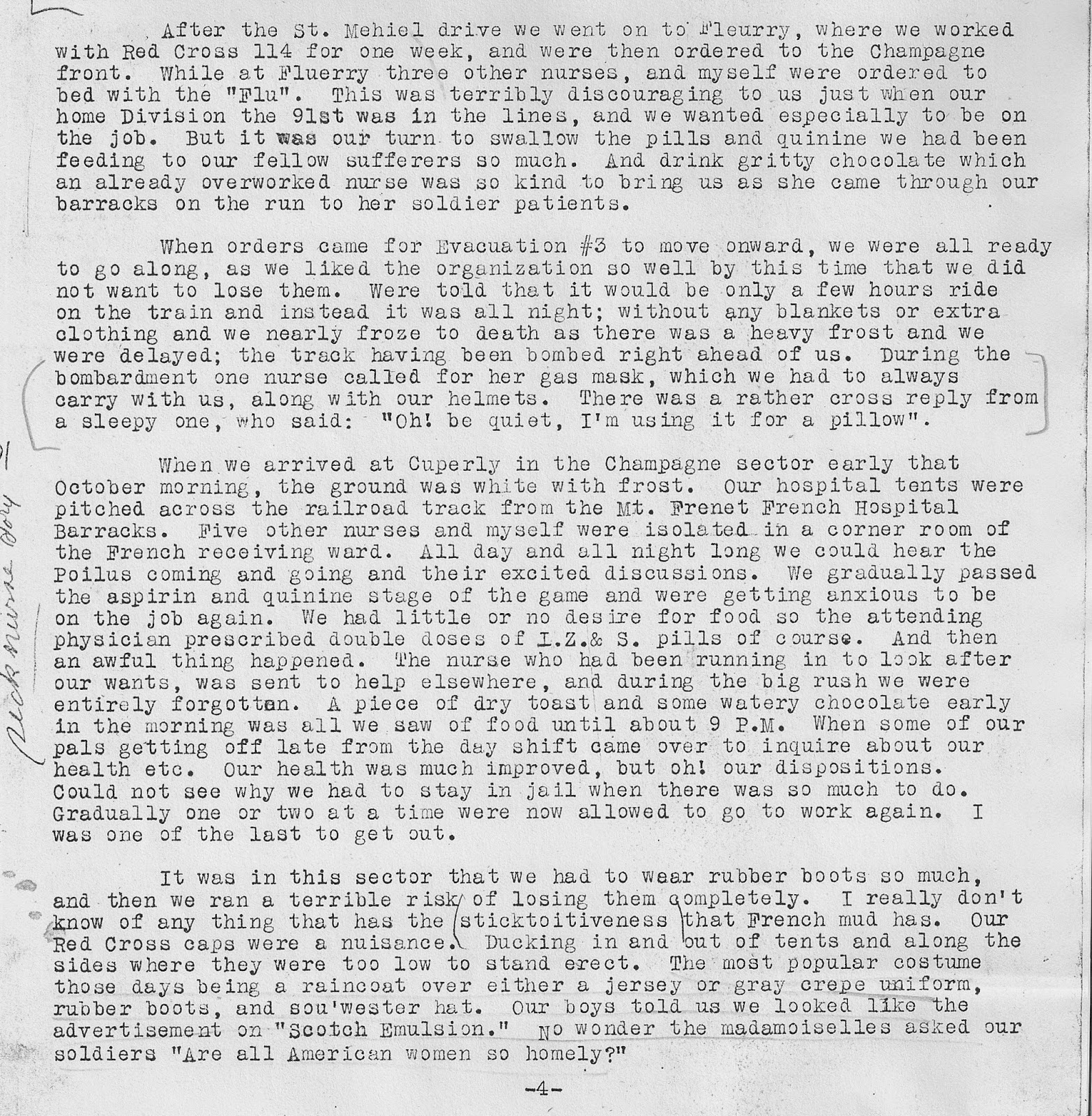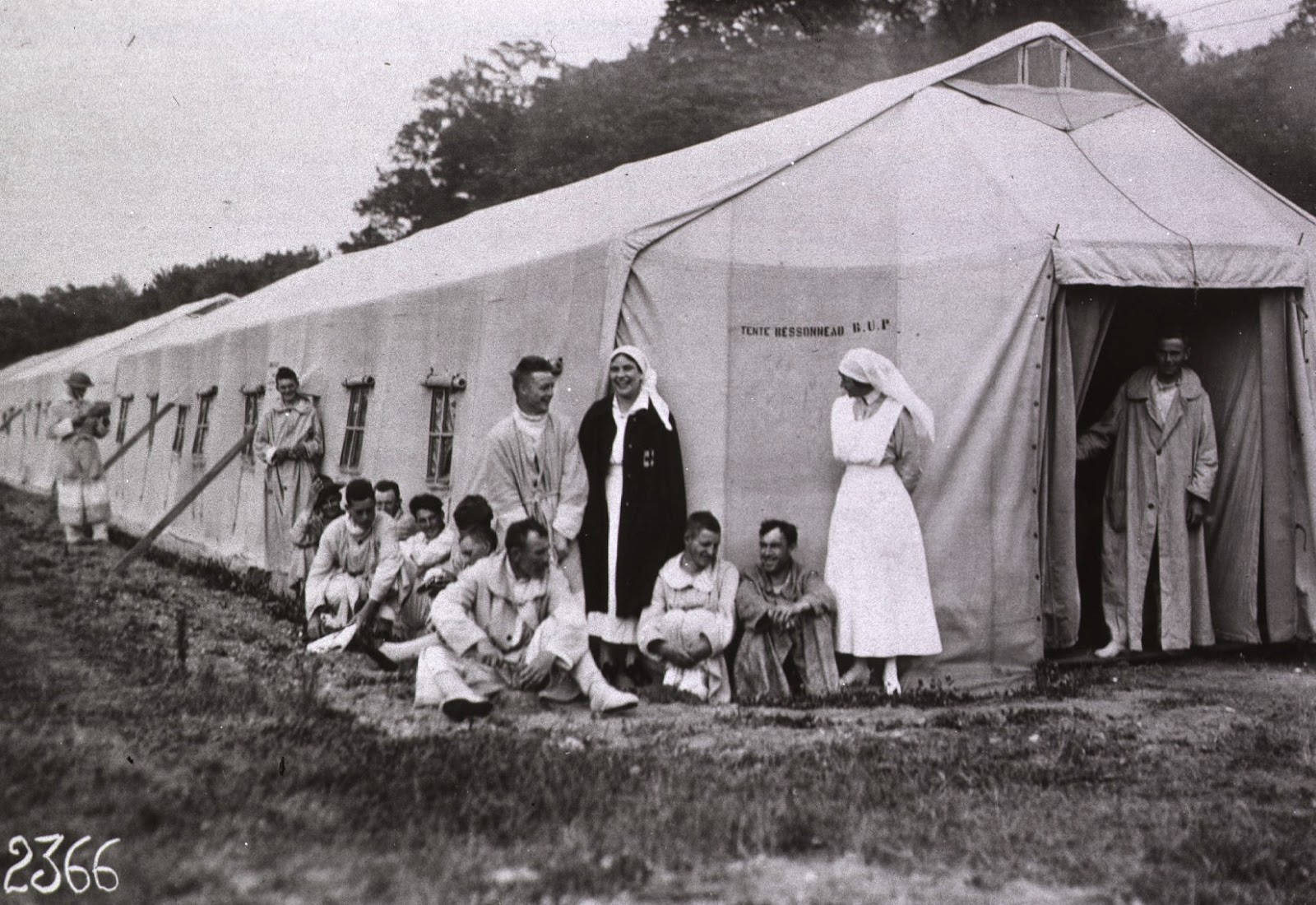To our great delight and good fortune, Oregon Base Hospital 46 nurse Winifred Franklin sent her impressions of her experiences in France during the First World War to Army Nurse Corps Superintendent Julia Stimson, preserved now at the National Archives in College Park, Maryland. Franklin's freestyle poetry reveals a very different part of the life of a nurse from the accounts I've posted, with jabs at her living conditions, the authority of Chief Nurse Grace Phelps, and the trials of military life in general, all in good fun. And thanks to a wonderful California high school research project we have a glimpse at more of her life before and after the war than is revealed in the materials from the Historical Collections & Archives at the Oregon Health & Science University and the National Archives.
 |
Winifred Franklin, R.N.
Grace Phelps Papers, Box 3, Binder 5, Base Hospital 46 Staff
Files, Historical Collections & Archives, Oregon Health & Science
University. Courtesy Historical Collections & Archives, OHSU. | |
According to her personnel file in the Grace Phelps papers at the Historical Collections & Archives at OHSU, Franklin was born in Los Angeles in 1899 and graduated from St. Joseph's Mercy Hospital Training School for Nurses in Clinton, Iowa in 1911. Before the war she engaged in private duty nursing. Like many staff members she battled sickness during her wartime service in France -- contracting diphtheria for the first two weeks of August, 1918; then falling ill with influenza on September 12 and 13 and again from December 28, 1918 to January 1, 1919 during the global epidemic of that disease.
Franklin's two free verse poems in the World War I Base Hospital Collection at the National Archives show a rank and file nurse with the confidence to write in a refreshing and irreverent voice, challenging authority and making fun of the rules and regulations, especially the curfew for nurses and the role of the night supervisor. She also lamented the less-than-stylish gray uniform spotted with Dakins solution, the antiseptic used during the conflict.
MY BARRACKS
One long building, sleek and thin, with [camouflaged] windows that sound like tin. With darned old floors as cold as ice. Even our bunks, they aren't nice. We have our friends both night and day. Those big French rats, how they can play. They love to promenade to and fro. They steal our grub, hard luck you know. The dear old store box pinned upon the wall, we use it for dresser and cupboard and all. They're all kinds of shapes, some fat and some tall, and the junk you pile in them - but they never fail.
In our little old rooms that are two by four, sometimes we're three, sometimes we're more. We even have wash rooms, and water (Beaucoup), with [camouflaged] trimmings and French stoves too. But our wash room's a wonder, you can't surmise. With ropes and lingerie in disguise. With basins and pails and pitchers galore, we usually find these all on the floor. No locks on the doors, which number two. One front door, one back door, and they're double, too. We sneak round and whisper low, then step on a board that rocks to and fro. Then someone hollers out in the night, "Can't you [go] to bed and put out that light?"
The saddest of tales has not been told. Its too sad to tell, too sad to hold. But the night supervisor is the jinks, I'll say, for when 9:30 comes it's just this way, she sneaks in the back door, and I'm here to say, she'll fine you in. She'll knock at your door, pretend to look wise, and sneak around and otherwise. Should you happen to be out, Oh! I'll never tell, she'll call again and again till all is well. If 9:30 is past, just take it from me, a little note is left for Miss Phelps to see. We sleep, and sleep until 5:30 A.M. then the strains of the bugle sound o'er the land - You got to get up, and you got to get up, you got to get up in the morning. Then the night supe, blithe and gay, with a whistle bold doth play - Get up, get up, you Army Nurse, I've worked all night, you only work 8 hours a day. We're up and dressed and raring to go, but listen girls, isn't this so. We love those old barracks, they have kept us warm. They have sheltered us and protected us from many a storm. They are free from hangins, free from care, and there's always a teakettle that lends an air to our home and Mother over there. And listen, girls, when we've crossed the deep, our barracks will be memories of the past while we sleep.
Winifred Franklin
Reserve Nurse, A[rmy] N[urse] C[orps]
MY ARMY DRESS
My Army dress, my army dress, of all my clothes I love you best. You hang so pretty, you're out so trim. I like your style, you've got the swing. We love your color, that grave-yard grey. We'll bury you deep when you've passed away. Your gray is spotted with Dakins hue. Your sleeves have shrunk with the rest of you. We dress up nice and admire ourselves. We look down the line and shadow ourselves. There goes a nurse dressed up just like you. She looks the part and so do you. But old grey dress, you've played your part. You're dear to your Kamarads, you're dear to my heart. But when I bury you, I'm here to say, Never again will I wear grey.
Winifred Franklin
Reserve Nurse
 |
| Winifred Franklin, "My Barracks," and "My Army Dress," Box 9, Base Hospitals, World War I,
Historical Records of the Army Nurses Corps Historical Data File,
1898-1947, Entry 10, Record Group 112, Records of the Office of Surgeon
General [Army], National Archives, College Park, Maryland. | | |
The students also drew from information in an undated clipping from the Oregonian they found among Candace McCorkell's collection. I was able to locate the article from the title they provided, a gift for which I am most grateful.
 |
| Melinda Owen, "90th Birthday Looms, Doesn't Slow Woman," Oregonian August 28, 1979, B2. |
Melinda Owen interviewed Winifred Frankie Reinig for this Oregonian article on August 28, 1979, several months before Winifred's 90th birthday. It contains many treasures about her life before and after her Base Hospital 46 experiences.
After nursing school Winifred "settled on a ranch in Montana with two friends in 1916." But "when she found that she would have to build a fence and a house to help her friends keep the land" she told them "this is for the birds." She just picked Portland "off the map" and made her move to a new home.
In the interview Winifred recalled that she "lived in constant fear of bombing raids" during her service in wartime France and had to "keep low on windy days to avoid the fumes of mustard and chlorine gases."
Winifred returned to Portland in 1919 and secured a nursing job at Emanuel Hospital (now Legacy Emanuel Medical Center in Portland) and married William Reinig in 1921. As with many women of her era, she quit wage work upon marriage, but volunteered at hospitals and provided medical care in her neighborhood. She was one of the charter members of the Portland Branch of the Women's Oveseas Service League, a veteran organization for women.
In "Frankie's" personnel file for Base Hospital 46 service, either Chief Nurse Grace Phelps or her successor Chief Nurse Eleanor Donaldson noted that she was "likeable and agreeable to patients" and had been found "breaking many rules." Here's to you, Winifred Franklin Reinig. "We have our friends both night and day. Those big French rats, how they can play . . . Listen, girls, when we've crossed the deep, our barracks will be memories of the past while we sleep."










































